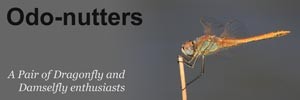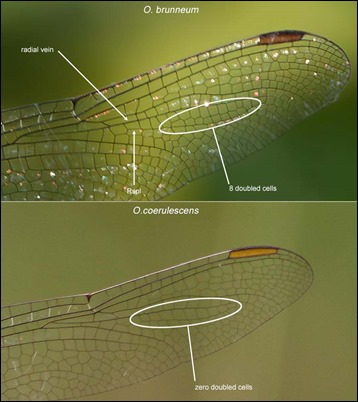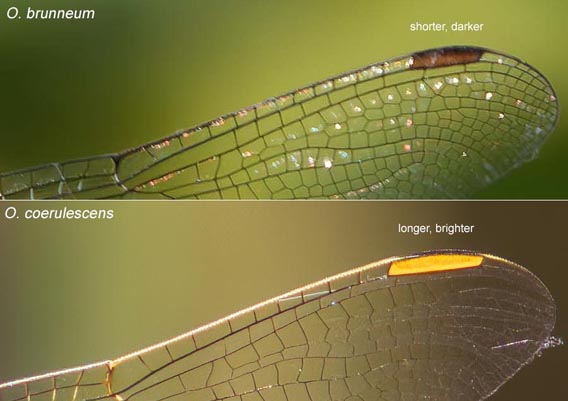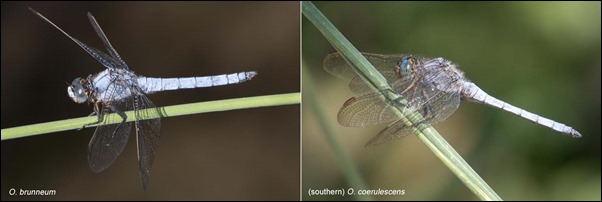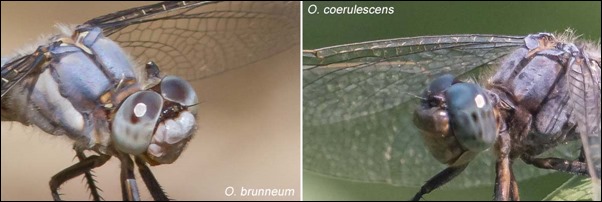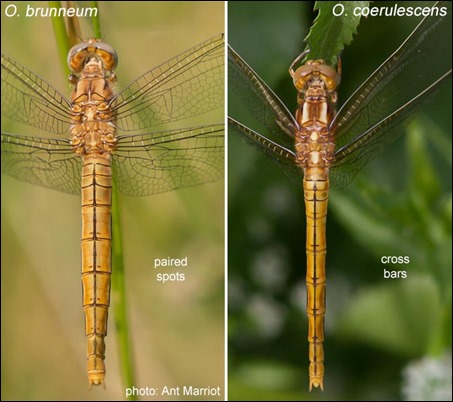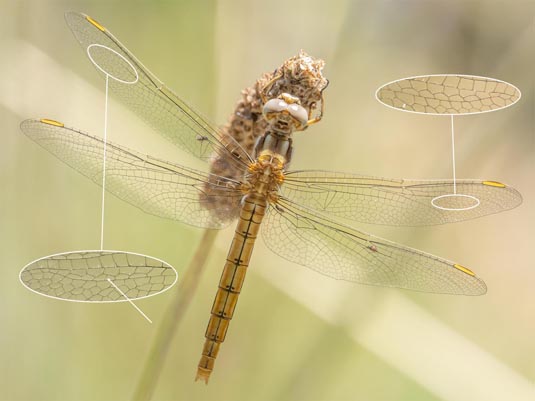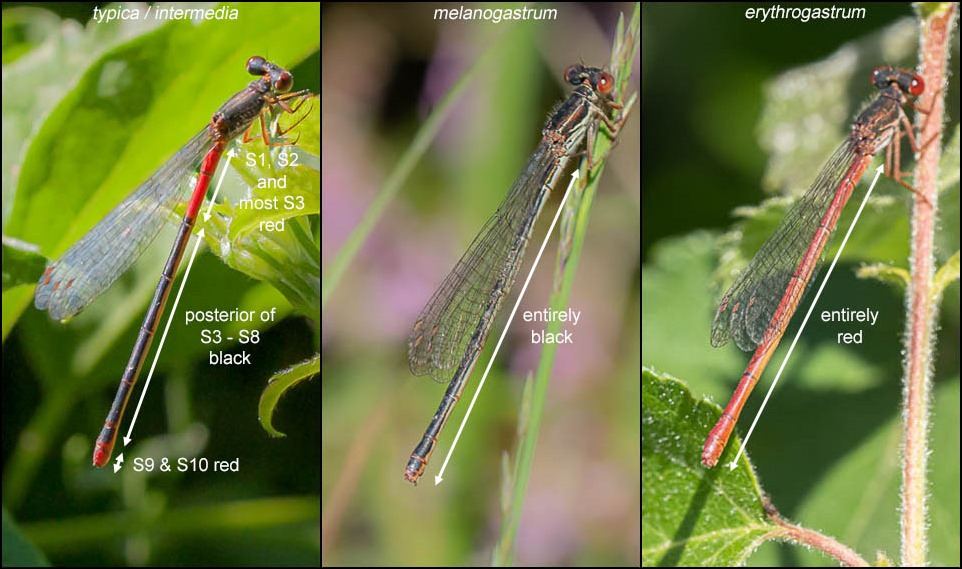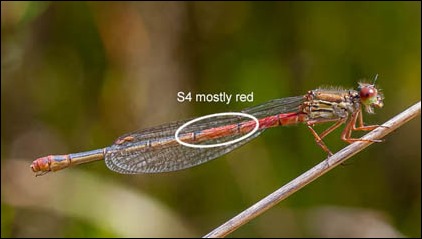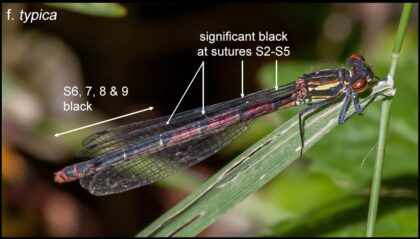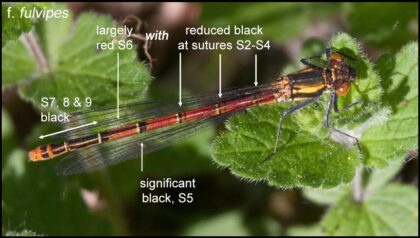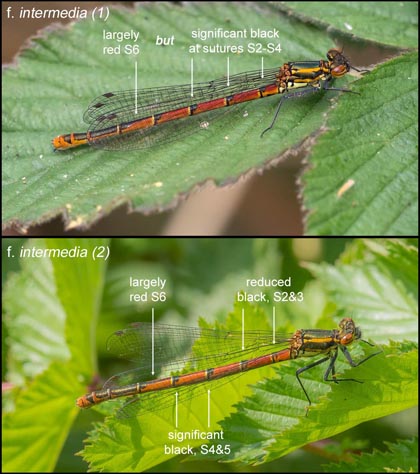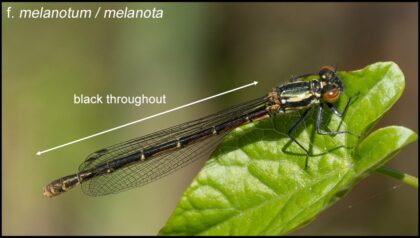In late 2019, just before Covid-19 ruined the world, I went on a 3-week intensive dragonfly hunting trip with Phil Benstead centred around Brisbane. The intention had been to go south into some of the State Parks of New South Wales but wild fires had struck forcing most parks to close. We ended up going north from Brisbane touring southern Queensland. Being one of Phil’s recce trips, that had been a tented camping safari. Worrisome at first, I became very fond of my little 1-man tent.
Finally, as the world technically opens up again, I went for a repeat performance with Phil. Phil had planned another trip to Far North Queensland [FNQ] centred around Cairns and it was not to be using tents, not being a recce, but shared accommodation in campsite chalets and motels. I had booked Qantas flights from Heathrow through Singapore to Sydney, with a connecting flight 3½ hours later up to Cairns. With a terminal change at Sydney, even for nervous ol’ me, a 3½ hour gap felt comfortable. It wasn’t. My Airbus A380 flight arrived in Sydney 2 hours late, then the bags took almost an hour to hit the carousel. With the Qantas transfer area being a complete zoo there was no chance of making my onward flight. Happily there was a backup flight 4 hours later which I did get rebooked onto so I arrived at Cairns late but on the correct day.
Our party numbered five in all; a very international mix of an American, a Frenchman and a German [sounds like the start of an old joke], as well as myself and Phil, a Brit who lives in Sweden. Once again, Phil’s research was exceptional. He was expecting 100 or so species. With no tents to set up, the days in the field were even longer than my first trip with him. We started at around 07:30 every day and went on for 10 or 11 hours in Wellington boots, typically. That’s very intense. I am always much more casual in my approach and took some time out when opportunities arose. Much of what we saw – and I expected to see less than my companions – would be new to me, anyway. I’m not much of a lister. With a lot of forested habitat, I found myself using flash more than usual (usual is rarely) and on one auspicious day I managed to fall headlong into a mountain river, completely submerging monopod, camera, lens and flash. I can now attest that Olympus’s claim that the M1X is waterproof is true. My 300 PRO lens misted up internally for three days but eventually dried out in the Queensland heat. The flash still works, too.
In theory this was wet season in FNQ but, from my viewpoint, we were very lucky with the weather suffering hardly any rain at all. I don’t do well with rain. I must say that I missed the privacy of my little tent but with the temperatures not dropping below 30°C accompanied by high humidity, tents with no aircon would have been uncomfortable.
Covering 16 very full days in the field, this is necessarily a long report. Here’s my indexed map with lists. As usual, the species noted are not exhaustive but limited to those that I personally saw. I racked up 79 species, 48 of which were new to me; 37 are endemic.
Cairns Botanic Gardens, 02 Dec [#1]
 Botanic gardens are always a good bet, usually being enjoyable habitats as well as productive, and this one was no exception. The exceptional find here was an aggregation of Camacinia othello (Black Knight), at least half a dozen, some of which actually settled and posed for our cameras.
Botanic gardens are always a good bet, usually being enjoyable habitats as well as productive, and this one was no exception. The exceptional find here was an aggregation of Camacinia othello (Black Knight), at least half a dozen, some of which actually settled and posed for our cameras.
- Argiocnemis rubescens (Red-tipped Shadefly)
- Ceriagrion aeruginosum (Redtail)
- Teinobasis rufithorax (Red-breasted Longtail)
- Indolestes tenuissimus (Slender Reedling)
- Agrionoptera insignis (Red Swampdragon)
- Brachydiplax denticauda (Palemouth)
- Brachydiplax duivenbodei (Darkmouth)
- Camacinia othello (Black Knight)
- Neurothemis stigmatizans (Painted Grasshawk)
- Orthetrum serapia (Green Skimmer)
- Rhodothemis lieftincki (Red Arrow)
- Rhyothemis phyllis (Yellow-striped Flutterer)
Cattana Wetlands @ Smithfield, 02 & 04 Dec [#2]
 Anything tagged “wetlands” is also a magnet and rightly so. In an interesting collection, I’d single out Zyxomma elgneri (Short-tailed Duskdarter) here, not only because it was new to me but also because the fact that it’s alphabetically the last genus in the World List.
Anything tagged “wetlands” is also a magnet and rightly so. In an interesting collection, I’d single out Zyxomma elgneri (Short-tailed Duskdarter) here, not only because it was new to me but also because the fact that it’s alphabetically the last genus in the World List.
- Indolestes tenuissimus (Slender Reedling)
- Ischnura heterosticta (Common Bluetail)
- Ischnura pruinescens (Colourful Bluetail)
- Teinobasis rufithorax (Red-breasted Longtail)
- Agrionoptera insignis allogenes (Red Swampdragon)
- Brachydiplax denticauda (Palemouth)
- Brachydiplax duivenbodei (Darkmouth)
- Ictinogoomphus australis (Australian Tiger)
- Nannodiplax rubra (Pygmy Percher)
- Nannophlebia eludens (Elusive Archtail)
- Neurothemis stigmatizans (Painted Grasshawk)
- Rhyothemis graphiptera (Graphic Flutterer)
- Rhyothemis princeps (Sapphire Flutterer)
- Zyxomma elgneri (Short-tailed Duskdarter)
Crystal Cascades, 03 Dec [#3]
A necessarily cut down list due to my not managing a couple of search areas – boots failed to grip a slope or two. This is an area that you need to be at early in the day to avoid Joe Public swimming in the cascades. 😉
 There were a few notables here but one with a decent picture is Oristicta filicicola (Slender Wiretail).
There were a few notables here but one with a decent picture is Oristicta filicicola (Slender Wiretail).
- Diphlebia euphoeoides (Tropical Rockmaster)
- Lestoidea conjuncta (Common Bluestreak)
- Oristicta filicicola (Slender Wiretail)
- Agrionoptera longitudinalis biserialis (Striped Swampdragon)
- Dromaeschna forcipata (Green-striped Darner)
- Eusynthemis nigra (Black Tigertail)
- Nannophlebia eludens (Elusive Archtail)
- Orthetrum villosovittatum (Fiery Skimmer)
Freshwater Creek, 03 Dec [#4]
 The river running beside our campground accommodation. Eventually a Choristhemis flavoterminata (Yellow-tipped Tigertail) settled advantageously.
The river running beside our campground accommodation. Eventually a Choristhemis flavoterminata (Yellow-tipped Tigertail) settled advantageously.
- Nososticta coelestina (Green-blue Threadtail)
- Pseudagrion ignifer (Flame-headed Riverdamsel)
- Pseudagrion microcephalum (Blue Riverdamsel)
- Austrogomphus prasinus (Lemon-tipped Hunter)
- Choristhemis flavoterminata (Yellow-tipped Tigertail)
- Diphlebia euphoeoides (Tropical Rockmaster)
Hunter Creek Park, 04 & 09 Dec [#5]
 Two visits here separated by a few days where we got a good view of a male Gompid with forked upper appendages, Austrogomphus prasinus (Lemon-tipped Hunter).
Two visits here separated by a few days where we got a good view of a male Gompid with forked upper appendages, Austrogomphus prasinus (Lemon-tipped Hunter).
- Diphlebia euphoeoides (Tropical Rockmaster)
- Ischnura pruinescens (Colourful Bluetail)
- Nososticta solitaria (Fivespot Threadtail)
- Austrogomphus prasinus (Lemon-tipped Hunter)
- Choristhemis flavoterminata (Yellow-tipped Tigertail)
- Orthetrum villosovittatum (Fiery Skimmer)
Rifle Creek Restarea, 04 Dec [#6]
A place where you can bump into some interesting folk as well as some interesting dragons.
 Macromia tillyardi (Australian Cruiser) was flying tirelessly over the river but I’m darned if I could snag it. Tetrathemis irregularis cladophila (Rainforest Elf) was much more cooperative.
Macromia tillyardi (Australian Cruiser) was flying tirelessly over the river but I’m darned if I could snag it. Tetrathemis irregularis cladophila (Rainforest Elf) was much more cooperative.
- Nososticta coelestina (Green-blue Threadtail)
- Macromia tillyardi (Australian Cruiser)
- Nannodiplax rubra (Pygmy Percher)
- Rhyothemis princeps (Sapphire Flutterer)
- Tetrathemis irregularis cladophila (Rainforest Elf)
Barron River, 04 Dec [#7]
 This rather unassuming location proved to be one of my personal favourites. The diminutive damselfly Agriocnemis argentea (Silver Wisp) was an absolute delight.
This rather unassuming location proved to be one of my personal favourites. The diminutive damselfly Agriocnemis argentea (Silver Wisp) was an absolute delight.
- Agriocnemis argentea (Silver Wisp)
- Diphlebia euphoeoides (Tropical Rockmaster)
- Nososticta solida (Orange Threadtail)
- Pseudagrion ignifer (Flame-headed Riverdamsel)
- Austrogomphus prasinus (Lemon-tipped Hunter)
- Choristhemis flavoterminata (Yellow-tipped Tigertail)
- Hemicordulia intermedia (Yellow-spotted Emerald)
- Orthetrum caledonicum (Blue Skimmer)
Emerald Creek Falls, 05 Dec [#8]
 This was a wonderfully rich location, initially because we’d arrived in the middle of a mass emergence of cicadas which were utterly deafening. The star dragonfly here, though, was a male Petalura ingentissima (Giant Petaltail), arguably the world’s largest species, which flew in and posed quite considerately for us. What a magnificent creature.
This was a wonderfully rich location, initially because we’d arrived in the middle of a mass emergence of cicadas which were utterly deafening. The star dragonfly here, though, was a male Petalura ingentissima (Giant Petaltail), arguably the world’s largest species, which flew in and posed quite considerately for us. What a magnificent creature.
- Diphlebia euphoeoides (Tropical Rockmaster)
- Indolestes tenuissimus (Slender Reedling)
- Austroepigomphus turneri (Flame-tipped Hunter)
- Austrogomphus divaricatus (Fork Hunter)
- Austrogomphus prasinus (Lemon-tipped Hunter)
- Diplacodes haematodes (Scarlet Percher)
- Dromaeschna forcipata (Green-striped Darner)
- Eusynthemis nigra (Black Tigertail)
- Hemicordulia australiae (Australian Emerald)
- Nannophlebia eludens (Elusive Archtail)
- Neurothemis stigmatizans (Painted Grasshawk)
- Petalura ingentissima (Giant Petaltail)
- Rhyothemis graphiptera (Graphic Flutterer)
- Tonyosynthemis claviculata (Clavicle Tigertail)
Mareeba Bicentennial Lakes, 05 Dec [#9]
 A visit towards the end of the day, so I was flagging a little. It’s a somewhat urban environment but the urbanization is at some distance so the dragons don’t mind. Rhyothemis graphiptera (Graphic Flutterer) posed quite well here.
A visit towards the end of the day, so I was flagging a little. It’s a somewhat urban environment but the urbanization is at some distance so the dragons don’t mind. Rhyothemis graphiptera (Graphic Flutterer) posed quite well here.
- Austroagrion watsoni (Eastern Billabongfly)
- Austrocnemis splendida (Splendid Longlegs)
- Pseudagrion microcephalum (Blue Riverdamsel)
- Crocothemis nigrifrons (Black-headed Skimmer)
- Ictinogomphus australis (Australian Tiger)
- Orthetrum caledonicum (Blue Skimmer)
- Rhodothemis lieftincki (Red Arrow)
- Rhyothemis graphiptera (Graphic Flutterer)
Jackaroo Motel Car Park, 06 Dec [#10]
 One star dragonfly, Austrogynacantha heterogena (Australian Duskhawker), was found roosting in the car park cement blocks. outside our rooms. It’s a crepuscular species and something of a wanderer so totally unpredictable and this location will be useless for anyone following but it’s here for the sake of completeness.
One star dragonfly, Austrogynacantha heterogena (Australian Duskhawker), was found roosting in the car park cement blocks. outside our rooms. It’s a crepuscular species and something of a wanderer so totally unpredictable and this location will be useless for anyone following but it’s here for the sake of completeness.
- Austrogynacantha heterogena (Australian Duskhawker)
Mount Lewis NP, 06 Dec [#11]
Not the greatest of days for me [understatement ].
 This was a drive up a mountain road looking for streams that crossed it. The streams were rocky and, of course, my companions spent all their time walking up and down in the water. I managed to trip on a submerged rock and fall in, complete with monopod, camera, 300 lens and flash unit. Miraculously all survived but the lens misted up with changing temperatures (aircon – outside heat) for a few days thereafter. I was nervous and chickened out of much of the subsequent action. I did manage a decent Austroargiolestes aureus (Tropical Flatwing) and very attractive they are, too.
This was a drive up a mountain road looking for streams that crossed it. The streams were rocky and, of course, my companions spent all their time walking up and down in the water. I managed to trip on a submerged rock and fall in, complete with monopod, camera, 300 lens and flash unit. Miraculously all survived but the lens misted up with changing temperatures (aircon – outside heat) for a few days thereafter. I was nervous and chickened out of much of the subsequent action. I did manage a decent Austroargiolestes aureus (Tropical Flatwing) and very attractive they are, too.
- Austroargiolestes aureus (Tropical Flatwing)
- Diphlebia hybridoides (Giant Rockmaster)
- Synlestes tropicus (Tropical Needle)
- Eusynthemis nigra (Black Tigertail)
Big Mitchell Creek, 06 & 09 Dec [#12]
 Big Mitchell Creek itself is actually inaccessible to Joe Public (without prior arrangement). This really relates to the areas just outside between the fence and the road. A high-key Diplacodes nebulosa (Charcoal-tipped Percher) hit the spot.
Big Mitchell Creek itself is actually inaccessible to Joe Public (without prior arrangement). This really relates to the areas just outside between the fence and the road. A high-key Diplacodes nebulosa (Charcoal-tipped Percher) hit the spot.
- Ischnura heterosticta (Common Bluetail)
- Ischnura pruinescens (Colourful Bluetail)
- Lestes concinnus (Dusky Spreadwing)
- Brachydiplax denticauda (Palemouth)
- Diplacodes nebulosa (Charcoal-tipped Percher)
- Orthetrum sabina (Slender Skimmer)
Mulligan Highway, nr Lakeland Quarry, 07 Dec [#13]
 My lens was suffering from steaming up after being dunked in a river but I manage to snag Austroepigomphus turneri (Flame-tipped Hunter) with its impressive red abdomen tip.
My lens was suffering from steaming up after being dunked in a river but I manage to snag Austroepigomphus turneri (Flame-tipped Hunter) with its impressive red abdomen tip.
- Austroepigomphus turneri (Flame-tipped Hunter)
- Crocothemis nigrifrons (Black-headed Skimmer)
- Rhodothemis lieftincki (Red Arrow)
Mulligan Highway, MoN, 07 Dec [#14]
 If only I could remember why I called this “MoN”. 😀 Here’s the Australian Neurothemis – N. fluctuans (Painted Grasshawk).
If only I could remember why I called this “MoN”. 😀 Here’s the Australian Neurothemis – N. fluctuans (Painted Grasshawk).
- Pseudagrion microcephalum (Blue Riverdamsel)
- Diplacodes trivialis (Chalky Percher)
- Neurothemis stigmatizans (Painted Grasshawk)
- Orthetrum caledonicum (Blue Skimmer)
- Rhodothemis lieftincki (Red Arrow)
Mulligan Highway, Billabong, 07 Dec [#15]
 Aethriamanta circumsignata (Square-spot Basker)
Aethriamanta circumsignata (Square-spot Basker)- Ictinogomphus australis (Australian Tiger)
- Tramea loewii (Common Glider)
Mulligan Highway, Desailly, 07 Dec [#18]
 A stop by the road that resulted in my only sighting of this tricky crepuscular species. Nigh on impossible to photograph flying in low light, here’s a very poor attempt.
A stop by the road that resulted in my only sighting of this tricky crepuscular species. Nigh on impossible to photograph flying in low light, here’s a very poor attempt.
- Tholymis tillarga (Twister)
Davies Creek, 08 Dec [#17]
 This a quite wide-ranging area where we worked two locations which I have combined into one. The first was at the actual falls which added just 2 species to the list. Another crepuscular celebrity made the day here, Telephlebia tillyardi (Tropical Evening Darner).
This a quite wide-ranging area where we worked two locations which I have combined into one. The first was at the actual falls which added just 2 species to the list. Another crepuscular celebrity made the day here, Telephlebia tillyardi (Tropical Evening Darner).
- Austroargiolestes icteromelas (Common Flatwing)
- Diphlebia euphoeoides (Tropical Rockmaster)
- Neosticta fraseri (Tropical Pinfly)
- Synlestes Tropicus (Tropical Needle)
- Austrophya mystica (Rainforest mystic)
- Austroaeschna speciosa (Tropical Unicorn Darner)
- Nannophlebia eludens (Elusive Archtail)
- Telephlebia tillyardi (Tropical Evening Darner)
- Tonyosynthemis claviculata (Clavicle Tigertail)
Davies Creek Road, 08 & 09 Dec [#18]
 I’ve kept this separate because it was one of the sites where we saw Petalura ingentissima (Giant Petaltail), though I didn’t get a photo of it from here.
I’ve kept this separate because it was one of the sites where we saw Petalura ingentissima (Giant Petaltail), though I didn’t get a photo of it from here.
- Austroargiolestes icteromelas (Common Flatwing)
- Indolestes tenuissimus (Slender Reedling)
- Synlestes Tropicus (Tropical Needle)
- Orthetrum villosovittatum (Fiery Skimmer)
- Petalura ingentissima (Giant Petaltail)
The Millstream, Ravenshoe, 10 Dec [#19]
 Close to our Airbnb rental property in Ravenshoe, where at least I had my own room but no aircon. There was a ceiling fan, though.
Close to our Airbnb rental property in Ravenshoe, where at least I had my own room but no aircon. There was a ceiling fan, though.
- Diphlebia euphoeoides (Tropical Rockmaster)
- Nososticta solitaria (Fivespot Threadtail)
- Austrogomphus prasinus (Lemon-tipped Hunter)
- Austrogomphus divaricatus (Fork Hunter)
- Eusynthemis nigra (Black Tigertail)
- Hemigomphus comitatus (Zebra Vicetail)
- Nannodiplax rubra (Pygmy Percher)
Millaa Millaa Waterfall, 10 Dec [#20]
 The waterfall itself is a leisure spot with Joe Public swimming; you have to follow the stream out to find odos. The rather oddly named Chorismagrion risi (Pretty Relict) was of interest here.
The waterfall itself is a leisure spot with Joe Public swimming; you have to follow the stream out to find odos. The rather oddly named Chorismagrion risi (Pretty Relict) was of interest here.
- Chorismagrion risi (Pretty Relict)
- Eusynthemis nigra (Black Tigertail)
Tully Gorge Lookout Track, 10 Dec [#21]
 Just one of any interest, here, but a challenging in-flight shot in shadowy lighting conditions.
Just one of any interest, here, but a challenging in-flight shot in shadowy lighting conditions.
- Dromaeschna forcipata (Green-striped Darner)
Archer Creek, 11 Dec [#22]
 Here we bumped into a new species, even a new genus, that I’d never even heard of, Pentathemis membranulata (Metallic Tigerhawk). Not the greatest photos but a bit of a lucky grab.
Here we bumped into a new species, even a new genus, that I’d never even heard of, Pentathemis membranulata (Metallic Tigerhawk). Not the greatest photos but a bit of a lucky grab.
- Nososticta solida (Orange Threadtail)
- Austrogomphus amphiclitus (Pale Hunter)
- Hemicordilia intermedia (Yellow-spotted Emerald
- Pentathemis membranulata (Metallic Tigerhawk)
Old Herbert River Crossing, 11 Dec [#23]
 This was a very productive site and really delivered the goods with a perched Cruiser, Macromia tillyardi (Australian Cruiser). In Europe a perched Macromia (different species) is a holy grail.
This was a very productive site and really delivered the goods with a perched Cruiser, Macromia tillyardi (Australian Cruiser). In Europe a perched Macromia (different species) is a holy grail.
- Nososticta solida (Orange Threadtail)
- Austrogomphus amphiclitus (Pale Hunter)
- Brachydiplax denticauda (Palemouth)
- Diplacodes haematodes (Scarlet Percher)
- Macromia tillyardi (Australian Cruiser)
- Nannophlebia risi (Common Archtail)
- Orthetrum caledonicum (Blue Skimmer)
- Rhyothemis braganza (Iridescent Flutterer)
Innot Hot Springs, 11 Dec [#24]
 Panic not, the dragonflies are not in the actual hot springs, there are ponds in that general area. This was my only meeting with Aciagrion fragile (Blue Slim) and thanks to my companions for the id.
Panic not, the dragonflies are not in the actual hot springs, there are ponds in that general area. This was my only meeting with Aciagrion fragile (Blue Slim) and thanks to my companions for the id.
- Aciagrion fragile (Blue Slim)
- Hydrobasileus brevistylus (Water Prince)
- Potamarcha congener (Swampwatcher)
- Tramea loewii (Common Glider)
- Urothemis aliena (Red Baron)
South Johnstone Campground Road, 12 Dec [#25]
 We made a number of stops up another campground road leading to a crossing over the South Johnstone River. There were a couple of interesting finds here not the least of which was Pseudocordulia circularis (Circle-tipped Mistfly).
We made a number of stops up another campground road leading to a crossing over the South Johnstone River. There were a couple of interesting finds here not the least of which was Pseudocordulia circularis (Circle-tipped Mistfly).
- Diphlebia euphoides (Tropical Rockmaster)
- Indolestes tropicus (Tropical Needle)
- Lestoidea sp (a Bluestreak male)
- Synlestes tropicus (Tropical Needle)
- Dromaeschna forcipata (Green-striped Darner)
- Hemigomphus theischingeri (Rainforest Vicetail)
- Pseudocordulia circularis (Circle-tipped Mistfly)
Henriette Creek, 12 Dec [#26]
- Austroargiolestes aureus (Tropical Flatwing)
Murray Falls, 13 Dec [#27]
 We met Orthetrum serapia (Green Skimmer) a number of times on this trip, making an interestinf comparison to a very similar looking old friend, Orthetrum sabina (Slender Skimmer).
We met Orthetrum serapia (Green Skimmer) a number of times on this trip, making an interestinf comparison to a very similar looking old friend, Orthetrum sabina (Slender Skimmer).
- Austrogomphus prasinus (Lemon-tipped Hunter)
- Diplacodes haematodes (Scarlet Percher)
- Orthetrum caledonicum (Blue Skimmer)
- Orthetrum serapia (Green Skimmer)
- Orthetrum villosovittatum (Fiery Skimmer)
TYTO Wetlands, Ingham 14 & 15 Dec [#28]
An interesting stop for a few reasons. First, our accommodation was in the Tropixx Motel and we couldn’t help but wonder about the double-x in the name. Secondly, Ingham is home to the original “pub with no beer”, though it is now not the original building, it having burnt down, and it now has beer. Lastly, the wetland is named after the genus of true Barn Owls.
 I had a very cooperative Rhyothemis princeps (Sapphire Flutterer) here, posing in plan view below a bridge.
I had a very cooperative Rhyothemis princeps (Sapphire Flutterer) here, posing in plan view below a bridge.
- Brachydiplax denticaude (Palemouth)
- Diplacodes haematodes (Scarlet Percher)
- Neurothemis stigmatizans (Painted Grasshawk)
- Orthetrum sabina (Slender Skimmer)
- Rhodothemis lieftincki (Red Arrow)
- Rhyothemis graphiptera (Graphic Flutterer)
- Rhyothemis princeps (Sapphire Flutterer)
- Urothemis aliena (Red Baron)
Alligators Nest Swimming Hole, 16 Dec [#29]
 First of all, there are no alligators in Australia and secondly, if there were, I doubt you’d want to go swimming with them. It was wonderful to see a female Petalura ingentissima (Giant Petaltail), though, the female being the larger of the two sexes.
First of all, there are no alligators in Australia and secondly, if there were, I doubt you’d want to go swimming with them. It was wonderful to see a female Petalura ingentissima (Giant Petaltail), though, the female being the larger of the two sexes.
- Petalura ingentissima (Giant Petaltail)
Josephine Falls Track, 17 Dec [#30]
 Another walk up a forest track to another waterfall examining streams along the way. I sat out at first but eventually joined in to get a reasonable Oristicta filicicola (Slender Wiretail).
Another walk up a forest track to another waterfall examining streams along the way. I sat out at first but eventually joined in to get a reasonable Oristicta filicicola (Slender Wiretail).
- Chorismagarion risi (Pretty Relict)
- Oristicta filicicola (Slender Wiretail)
Robert Road Park, 17Dec [#31]
 This was parkland surrounded by housing estates with a rather scruffy stream that seemed more of a rubbish dump used by the local inhabitants. It was home to a very appealing Argiocnemis rubescens (Red-tipped Shadefly), though.
This was parkland surrounded by housing estates with a rather scruffy stream that seemed more of a rubbish dump used by the local inhabitants. It was home to a very appealing Argiocnemis rubescens (Red-tipped Shadefly), though.
- Argiocnemis rubescens (Red-tipped Shadefly)
- Oristicta filicicola (Slender Wiretail)
- Nannophlebia eludens (Elusive Archtail)
 My title stems from two documented concepts. In photography, the circle of confusion is used to determine the depth of field, that part of an image which is acceptably sharp. In linguistics, the triangle of meaning is a model of how linguistic symbols relate to the objects they represent. Both triangle and confusion seem particularly relevant to my subject, pictured right.
My title stems from two documented concepts. In photography, the circle of confusion is used to determine the depth of field, that part of an image which is acceptably sharp. In linguistics, the triangle of meaning is a model of how linguistic symbols relate to the objects they represent. Both triangle and confusion seem particularly relevant to my subject, pictured right. The species scientific name stems from the isosceles triangle mark atop S2, present in both sexes. It was apparently first described by the Danish naturalist Otto Friedrich Müller in 1767. Whether by accident or design, his species name of isoceles omitted the 2nd “s” that appears before the middle “c” in geometric terminology. I have seen one claim that the original specific name was isosceles (with the “s”) but there was no attribution and that doesn’t seem to gel with the apparent original name of isoceles from good ol’ Müller.
The species scientific name stems from the isosceles triangle mark atop S2, present in both sexes. It was apparently first described by the Danish naturalist Otto Friedrich Müller in 1767. Whether by accident or design, his species name of isoceles omitted the 2nd “s” that appears before the middle “c” in geometric terminology. I have seen one claim that the original specific name was isosceles (with the “s”) but there was no attribution and that doesn’t seem to gel with the apparent original name of isoceles from good ol’ Müller.